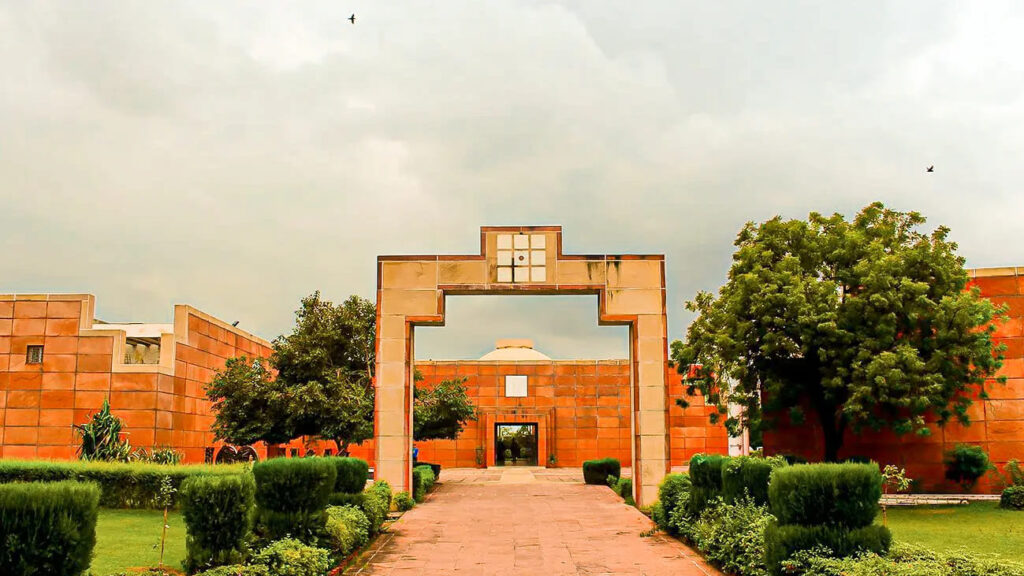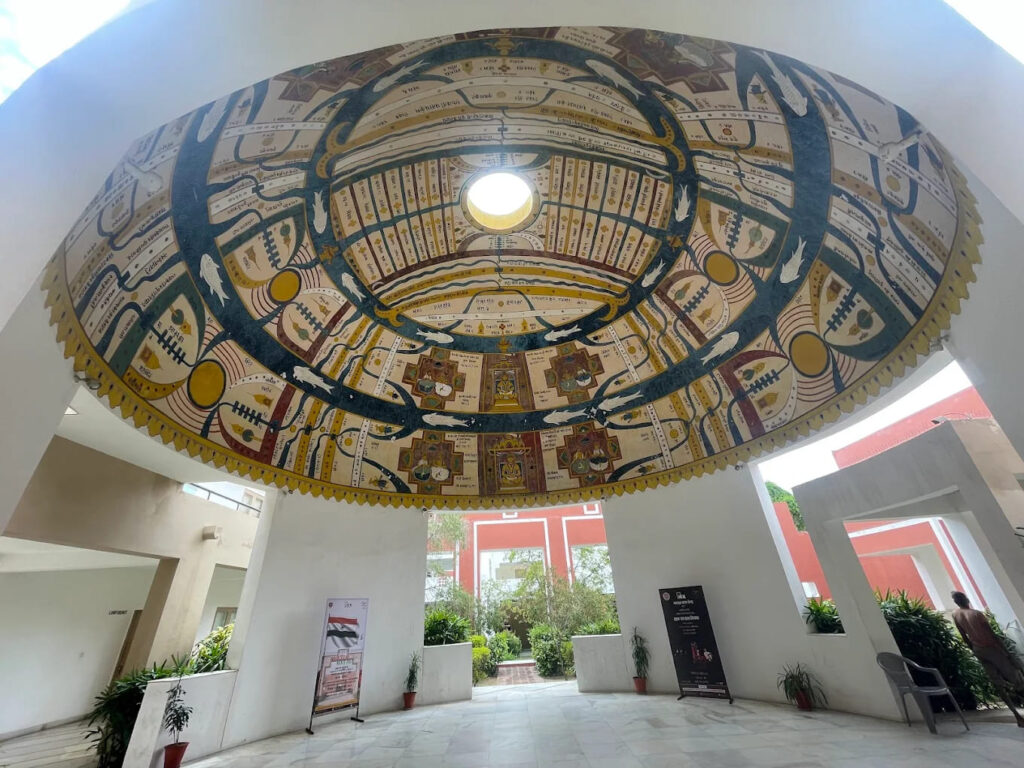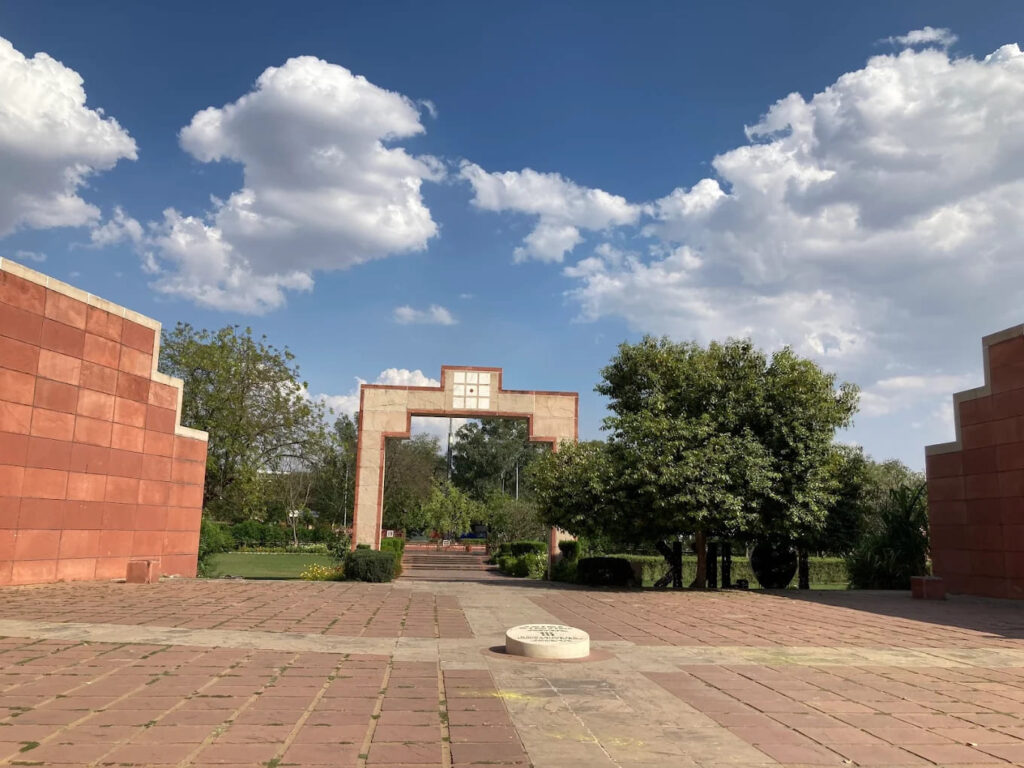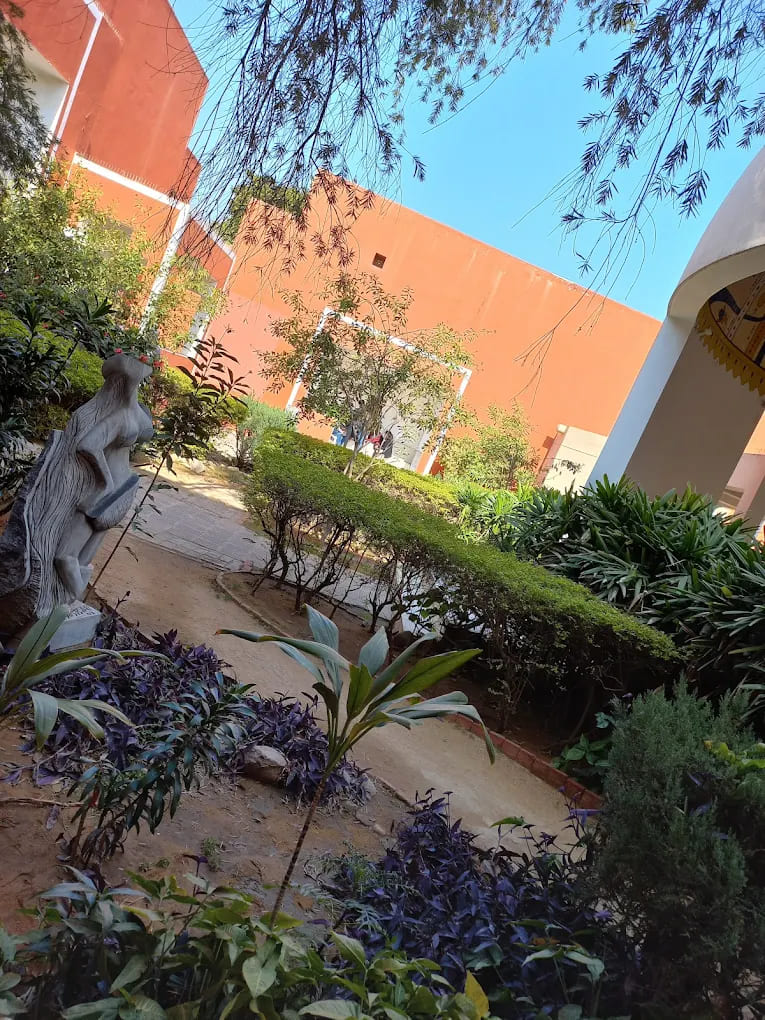A perfect blend of art, architecture, and culture, the Jawahar Kala Kendra (JKK) in Jaipur is one of India’s most celebrated creative spaces. Established in 1993, this iconic art and cultural center was designed by the world-renowned architect Charles Correa and dedicated to Pandit Jawaharlal Nehru, India’s first Prime Minister.

Located on JLN Marg, the Jawahar Kala Kendra stands as a symbol of Jaipur’s evolving artistic identity, where tradition meets modernity. The complex not only showcases the architectural brilliance of Correa’s design but also serves as a living museum for visual arts, crafts, theatre, dance, and literature.
Spread across 9 squares inspired by the Navagraha (nine planets), the building reflects both cosmic geometry and Rajasthani aesthetics. Every courtyard, corridor, and gallery has been thoughtfully designed to create an immersive experience for artists, scholars, and visitors alike.
Whether you’re an art lover, architect, or cultural enthusiast, the Jawahar Kala Kendra Jaipur offers an enriching journey through India’s creative spirit, making it one of the must-visit attractions in the Pink City.
History & Background of Jawahar Kala Kendra Jaipur
The Jawahar Kala Kendra (JKK) was established in 1993 by the Government of Rajasthan as a pioneering initiative to promote and preserve India’s diverse art forms. Conceived as a multi-arts center, its purpose was to provide a platform where artists, performers, and scholars could collaborate, exhibit, and celebrate creativity in all its forms.

Tribute to Jawaharlal Nehru
The center was named after Pandit Jawaharlal Nehru, India’s first Prime Minister, in recognition of his vision for a modern and culturally rich India. “Kala Kendra” translates to “Art Center,” perfectly describing its mission — to serve as a home for visual and performing arts that reflect India’s cultural heritage and evolving artistic identity.
Architectural Vision by Charles Correa
The government commissioned Charles Correa, one of India’s most celebrated architects, to design the complex. Correa envisioned a structure that would embody both Jaipur’s traditional city planning and contemporary architectural principles.
Inspired by the Navagraha Mandala (nine-planet cosmic diagram), he used Vastu Shastra geometry to divide the structure into nine interlocking squares, each representing a celestial planet.
This unique design not only symbolizes the cosmic order but also reflects Jaipur’s grid-based urban plan established by Maharaja Sawai Jai Singh II in the 18th century.
A Living Cultural Landmark
Since its inception, JKK has become a cultural heartbeat of Rajasthan, hosting exhibitions, film screenings, theatre performances, literary festivals, and craft fairs. It continues to serve as a vibrant meeting ground for artists, architects, writers, and visitors from around the world.
Architectural Design & Concept of Jawahar Kala Kendra Jaipur
The architecture of Jawahar Kala Kendra (JKK) is a masterpiece that merges ancient Indian philosophy with modern design sensibilities. Designed by the legendary architect Charles Correa, the structure embodies Jaipur’s geometric planning traditions while celebrating the cosmic order of the universe.

1. Inspired by the Navagraha Mandala (Nine Planets Concept)
The design of JKK is based on the Navagraha Mandala, a symbolic representation of the nine planets in Hindu cosmology.
Correa divided the entire complex into nine interlocking squares (mandalas), each representing one of the celestial bodies.
- Eight squares are used for galleries, theatres, workshops, and performance spaces.
- The ninth, central square represents the void or cosmic center, symbolizing balance and connection between the physical and spiritual worlds.
This cosmic geometry reflects the ancient Indian belief that art and the universe are deeply intertwined.
2. Blend of Tradition & Modernity
The structure mirrors the grid-based urban design of Jaipur’s old city, originally conceptualized by Maharaja Sawai Jai Singh II in the 18th century.
Correa reinterpreted this layout using red sandstone and white marble, the same materials that define Jaipur’s heritage architecture.
The corridors, courtyards, and stairways create a rhythm of light and shadow, a hallmark of Correa’s architectural genius. Each courtyard opens into a new experience, blending space, air, and light in harmony.
3. Architectural Highlights
- Open Courtyards: Promote interaction and natural ventilation.
- Galleries: Designed to hold both sunlight and shadow for dynamic art displays.
- Amphitheatre: An open-air performance space used for theatre, music, and cultural festivals.
- Use of Materials: Locally sourced Jaipur stone and handcrafted details add an earthy authenticity.
- Spatial Symbolism: The architecture encourages visitors to move inward, from the outer squares toward the spiritual core — much like a mandala meditation.
4. Symbol of Cosmic Harmony
Through JKK, Correa achieved more than a building, he created an architectural philosophy. It reflects Jaipur’s scientific heritage, spiritual symbolism, and cultural continuity, positioning the center as one of India’s finest examples of contemporary vernacular architecture.
Also Check: Albert Hall Museum Jaipur
What to See at Jawahar Kala Kendra Jaipur
The Jawahar Kala Kendra (JKK) isn’t just an architectural marvel, it’s a vibrant space that celebrates art, design, literature, and performance. Every corner of the complex offers something unique, making it one of the most inspiring places to visit in Jaipur for artists, students, and tourists alike.
1. Art Galleries
- JKK houses multiple art galleries such as the Parijat, Sukriti, Surekh, and Alankar galleries, showcasing rotating exhibitions of painting, sculpture, photography, and installations.
- These galleries feature works by renowned Indian artists as well as emerging local talents, offering a deep insight into Rajasthan’s creative landscape.
- From contemporary art to tribal expressions, the collection represents the diversity of India’s visual culture.
2. Craft Exhibitions & Museums
- The complex frequently hosts handicraft exhibitions and workshops where artisans display pottery, textiles, jewelry, and traditional crafts.
- Visitors can interact directly with craftsmen and even purchase authentic Rajasthani handmade items.
- Occasionally, temporary museum-style exhibits are curated to highlight Rajasthan’s folk traditions and indigenous art forms.
3. Amphitheatre & Auditoriums
- JKK’s open-air amphitheatre, called Madhyavarti, is one of its most striking features.
- It serves as the stage for theatre plays, musical evenings, folk dances, film screenings, and major cultural festivals.
- The indoor Rangayan Auditorium is equipped with modern acoustics and lighting, regularly hosting performing arts, theatre productions, and poetry recitals.
4. Library & Research Center
- The Jawahar Kala Kendra Library is a treasure trove for students and researchers interested in art, architecture, design, and Indian culture.
- It features rare books, manuscripts, and journals, making it an intellectual hub within the center.
5. Café & Bookstore
- The Café Quaint inside JKK is a favorite among locals and visitors for its calm ambiance, delicious food, and artistic vibe.
- There’s also a bookshop and souvenir store where you can buy art books, postcards, and local crafts.
6. Courtyards & Open Spaces
- The beautifully designed courtyards and corridors serve as informal meeting points for artists and visitors.
- You’ll often find art installations, student performances, or just groups of creatives sketching and brainstorming.
Cultural Events & Festivals at Jawahar Kala Kendra Jaipur
The Jawahar Kala Kendra (JKK) is not just an art complex, it’s the beating heart of Jaipur’s cultural scene. Throughout the year, it hosts a wide range of festivals, exhibitions, workshops, and performances that celebrate creativity in every form. These events attract artists, performers, scholars, and audiences from all over India and beyond.

Here’s a glimpse into the vibrant cultural life of JKK:
1. Theatre & Performing Arts
- JKK’s Rangayan Auditorium and open-air amphitheatre regularly feature theatre productions, classical music concerts, dance recitals, and poetry readings.
- Plays by legendary theatre personalities and regional troupes often grace its stage, making it one of India’s best-known venues for live performing arts.
2. Art Exhibitions & Installations
- The center continuously hosts solo and group art exhibitions, featuring both contemporary and traditional artists.
- The themes range from folk art and photography to modern visual storytelling, often curated by leading art critics and institutions.
- Large-scale public art installations often adorn the courtyards, blending architecture with creativity.
3. Festivals & Annual Events
Some of the most popular festivals organized at JKK include:
- Rajasthan International Folk Festival (RIFF) – Celebrates folk music and heritage.
- Rajasthan International Film Festival (RIFF Jaipur) – Screenings and discussions on global cinema.
- Jaipur Kala Mahotsav – A grand annual arts festival featuring dance, theatre, and fine arts.
- Navras Festival – A week-long cultural festival showcasing music, literature, and performing arts.
- Craft Melas & Literature Festivals – Seasonal fairs where artisans, writers, and performers interact with the public.
4. Workshops & Art Residencies
- Regular workshops on pottery, painting, photography, theatre, and handicrafts invite participants of all skill levels.
- The artist-in-residence programs nurture emerging talent by providing space, mentorship, and exposure.
5. Film Screenings & Cultural Discussions
- JKK often collaborates with institutions like the Rajasthan Lalit Kala Akademi and National School of Drama for film screenings, art talks, and interactive sessions.
- These events make it a hub for intellectual exchange and cross-cultural dialogue.
Location & How to Reach Jawahar Kala Kendra Jaipur
The Jawahar Kala Kendra (JKK) is conveniently located in the heart of Jaipur city on the famous Jawaharlal Nehru Marg (JLN Marg), one of the city’s main cultural and educational arteries. Its central location makes it easily accessible from all major landmarks and transport hubs in Jaipur.
Address
Jawahar Kala Kendra (JKK) – JLN Marg, Opposite Rajasthan University, Jaipur, Rajasthan – 302004
Google Map Location: https://maps.app.goo.gl/nUU4DLc5B9g5KAEfA
How to Reach
By Auto-Rickshaw or Cab
- Auto-rickshaws and app-based cabs like Ola and Uber are the most convenient ways to reach JKK.
- Just type “Jawahar Kala Kendra Jaipur” in Google Maps — it’s a well-known location among locals.
By Metro
- Nearest Metro Station: Civil Lines Metro Station (approx. 3.5 km away).
- From there, hire an auto or e-rickshaw to reach the center in 10–15 minutes.
By Bus
- Local Jaipur City Transport buses regularly run on JLN Marg.
- The nearest bus stop is Rajasthan University, just a 2-minute walk from JKK.
By Car or Taxi
- JKK is well-connected via JLN Marg and Tonk Road, about:
- 5 km from Jaipur Railway Station
- 8 km from Sindhi Camp Bus Stand
- 9 km from Jaipur International Airport
Also Check: 10 Must-Visit Places in Jaipur
Timings & Entry Fee of Jawahar Kala Kendra Jaipur
Before planning your visit to this artistic landmark, it’s important to know the opening hours, entry fees, and accessibility details for the Jawahar Kala Kendra (JKK). The center welcomes visitors throughout the week, except on Mondays, offering a serene yet inspiring atmosphere for art lovers and tourists alike.
Jawahar Kala Kendra Jaipur Timings
| Day | Opening Hours |
|---|---|
| Tuesday – Sunday | 10:00 AM – 7:00 PM |
| Monday | Closed (weekly holiday) |
Best visiting hours:
Morning (10 AM – 12 PM) for a calm exploration, or late evening (5 PM – 7 PM) when events and exhibitions are often active.
Entry Fee
- Entry Fee: Free for general visitors.
- Paid Entry: Only during certain festivals, exhibitions, or special performances.
- Photography is allowed in open areas, but sometimes restricted inside galleries or auditoriums (depending on event regulations).
Best Time to Visit Jawahar Kala Kendra Jaipur
The Jawahar Kala Kendra (JKK) can be visited year-round, but the experience becomes truly special during certain months and times of day when Jaipur’s weather and the center’s cultural calendar align perfectly.
Best Season to Visit
- October to March is considered the best time to visit JKK Jaipur.
During this period, the weather is pleasant, and the center hosts most of its art festivals, craft fairs, and cultural events. - Major festivals like Navras, Kala Mahotsav, and literature events take place between November and February, attracting artists and tourists from across the world.
Best Time of Day
- Morning (10 AM – 12 PM): Ideal for quiet exploration, photography, and architecture enthusiasts who want to study Charles Correa’s design in soft daylight.
- Evening (4 PM – 7 PM): Perfect for catching live performances, exhibitions, and enjoying coffee at the in-house Café Quaint.
As the sun sets, the sandstone structure glows beautifully, a treat for photographers.
Best Time for Events & Festivals
- Visit during weekends or special exhibitions for the most vibrant experience.
- Follow JKK’s official social media handles or the Rajasthan Tourism events calendar to stay updated about ongoing festivals and workshops.
Nearby Attractions Around Jawahar Kala Kendra Jaipur
Located on the scenic JLN Marg, the Jawahar Kala Kendra (JKK) is surrounded by some of Jaipur’s most beautiful and culturally rich landmarks. Whether you’re an art lover, a history buff, or a casual traveler, you can easily combine your visit to JKK with these nearby attractions for a perfect day in the Pink City.
1. Birla Mandir (1 km)
- One of Jaipur’s most famous temples, Birla Mandir (also known as the Laxmi Narayan Temple) is just a 5-minute drive from JKK.
- Built entirely of white marble, it’s especially stunning during sunset and at night when illuminated.
2. Central Park (1.5 km)
- A vast green oasis ideal for morning walks, bird watching, and photography.
- The park also features a musical fountain, jogging track, and a massive Indian national flag visible from afar.
3. Albert Hall Museum (3 km)
- Jaipur’s oldest museum, housing ancient artifacts, miniature paintings, musical instruments, and sculptures.
- Located near Ram Niwas Garden, it’s a must-visit for art and history enthusiasts.
4. Hawa Mahal (5 km)
- The iconic Palace of Winds, built in 1799, is one of Jaipur’s top tourist attractions.
- Its pink sandstone façade and intricate lattice windows make it a photographer’s delight.
5. City Palace Jaipur (5 km)
- A blend of Mughal and Rajput architecture, the City Palace complex includes royal courtyards, museums, and galleries.
- It gives visitors an intimate look at Jaipur’s royal history.
6. Bapu Bazaar & Nehru Bazaar (4–5 km)
- These vibrant local markets are great for buying Jaipuri textiles, mojaris, handicrafts, and souvenirs.
- Perfect for a cultural and shopping-filled end to your day after exploring JKK.
FAQs About Jawahar Kala Kendra Jaipur
What is Jawahar Kala Kendra famous for?
The Jawahar Kala Kendra (JKK) is famous for its unique architecture designed by Charles Correa, inspired by the Navagraha (nine planets) concept, and for being a major hub of art, culture, and creativity in Jaipur. It regularly hosts exhibitions, theatre performances, film screenings, and art festivals.
Who designed the Jawahar Kala Kendra Jaipur?
It was designed by the world-renowned Indian architect Charles Correa in 1993. His design blends traditional Vastu principles with modern architecture, making JKK an internationally recognized example of contemporary Indian design.
What are the opening hours of Jawahar Kala Kendra Jaipur?
The center is open Tuesday to Sunday from 10:00 AM to 7:00 PM, and remains closed on Mondays.
Is there any entry fee for Jawahar Kala Kendra?
No, entry is free for general visitors. However, certain special exhibitions or performances may have a small entry or ticket fee.
What can visitors see at Jawahar Kala Kendra?
Visitors can explore:
Art galleries showcasing local and national artists.
Amphitheatre and auditoriums for cultural events.
Library, café, and craft exhibitions.
Stunning architectural courtyards and design elements.
Where is Jawahar Kala Kendra located?
It is located on JLN Marg, opposite Rajasthan University, Jaipur – 302004, in the heart of the city.
What are the main events held at Jawahar Kala Kendra?
Major events include:
Navras Festival
Jaipur Kala Mahotsav
Rajasthan International Film Festival (RIFF)
Art and craft fairs, folk music shows, and literature events.
What is the best time to visit Jawahar Kala Kendra Jaipur?
The best time to visit is between October and March, especially in the evenings when the complex hosts cultural events and the sandstone structure glows beautifully under the golden light.
How much time is needed to explore Jawahar Kala Kendra?
You should plan to spend at least 1.5 to 2 hours exploring the galleries, café, and courtyards. If attending a performance or workshop, set aside 3 to 4 hours for a complete experience.
